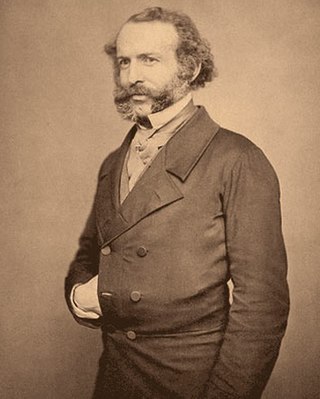
John Rae was a Scottish surgeon who explored parts of northern Canada.
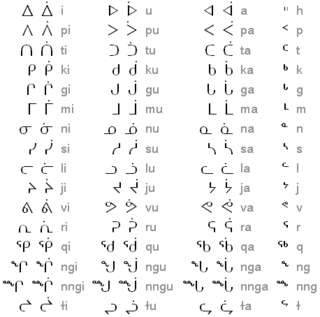
Inuktitut syllabics is an abugida-type writing system used in Canada by the Inuktitut-speaking Inuit of the territory of Nunavut and the Nunavik and Nunatsiavut regions of Quebec and Labrador, respectively. In 1976, the Language Commission of the Inuit Cultural Institute made it the co-official script for the Inuit languages, along with the Latin script.
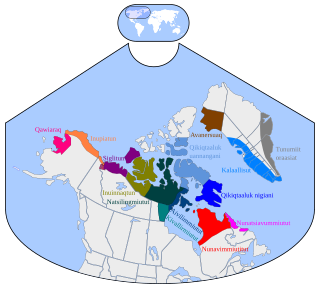
Inuktitut, also known as Eastern Canadian Inuktitut, is one of the principal Inuit languages of Canada. It is spoken in all areas north of the North American tree line, including parts of the provinces of Newfoundland and Labrador, Quebec, to some extent in northeastern Manitoba as well as the Northwest Territories and Nunavut. It is one of the aboriginal languages written with Canadian Aboriginal syllabics.
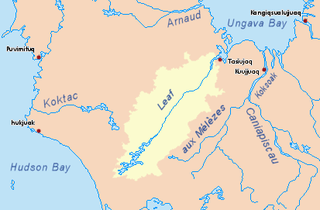
Leaf River is a river in northern Quebec, Canada, at the northern limit of the tree line. It flows from Lake Minto northeast through the Ungava Peninsula into Leaf Bay off Ungava Bay over a distance of 480 kilometres (300 mi). At the head of Leaf Bay is the Inuit community of Tasiujaq.
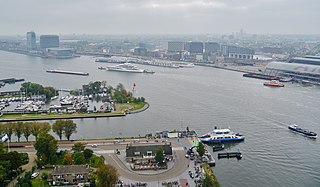
The IJ is a body of water, formerly a bay, in the Dutch province of North Holland. It is known for being Amsterdam's waterfront.
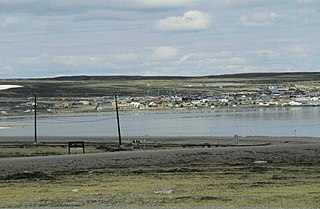
Baker Lake is a lake in the Kivalliq Region, Nunavut, Canada. It is fed by the Thelon River from the west and the Kazan River from the south. It outflows into Chesterfield Inlet. The lake is approximately 1,887 km2 (729 sq mi) in size. It has several named bays, and a few islands.
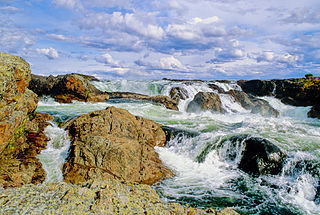
The Kazan River, is a Canadian Heritage River located in Nunavut, Canada. The Dene name for the river was Kasba-tue meaning "white partridge river." The name was apparently changed to Kazan in the late 19th century due to the influence of Order of Mary Immaculate missionaries. The river headwaters are in northern Saskatchewan at Kasba Lake, and it flows north for about 1,000 kilometres (620 mi) before emptying into Baker Lake, on the opposite side of the mouth of the Thelon River. Along its course the river flows through several lakes, including Ennadai Lake and Yathkyed Lake, over the Kazan Falls, down a red sandstone gorge and through both boreal forest and tundra. It is the last section of the river, below Ennadai Lake, that is above the timber line and is designated a Canadian Heritage River.

Charpentier River is a river in northern Quebec, Canada, that flows from Lac Nedlouc for about 125 km (78 mi) northwest to Lake Minto. A rarely paddled river, it flows through tundra & taiga. It has several waterfalls, namely Chutes de Burin and Chute Bleu. It is one of the main tributaries of the Leaf River.

Garry Lake is a lake in sub-Arctic Kivalliq Region, Nunavut, Canada. As a portion of the Back River waterway, Garry Lake originates directly east of Lake Pelly and drains to the east by the Back River. A set of rapids separate Buliard Lake from Garry Lake. Two other sets of rapids separate Garry Lake's three sections which are also differentiated by elevation. Garry Lakes are isolated from nearby communities.

Vachon River is a river in the Arctic tundra of Nunavik, Quebec. It originates on Lac Laflamme at 61°21′49″N73°45′36″W just north of Pingualuit crater and finishes at 60°4′43″N71°8′59″W where it joins Arnaud/Payne River. It was named after bishop Alexander Vachon (1885–1953), rector of Laval University in 1939 and from 1940 to 1953, archbishop of the diocese of Ottawa, Ontario.
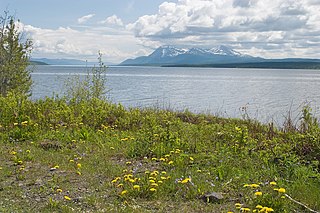
Teslin Lake is a large lake spanning the border between British Columbia and Yukon, Canada. It is one of a group of large lakes in the region of far northwestern BC, east of the upper Alaska Panhandle, which are the southern extremity of the basin of the Yukon River, and which are known in Yukon as "the Southern Lakes". The lake is fed and drained primarily by the Teslin River, south and north, but is also fed from the east by the Jennings River and the Swift River, and from the west by the Hayes River.

Kangirsuk is an Inuit village in northern Nunavik, Quebec, Canada. It is 230 kilometres (140 mi) north of Kuujjuaq, between Aupaluk and Quaqtaq. The community is only accessible by air and, in late summer, by boat. The village used to be known also as Payne Bay and Bellin.

The Zarrineh Rud is a river in Kurdistan Province and West Azarbaijan Province, Iran.
This article discusses the phonology of the Inuit languages. Unless otherwise noted, statements refer to Inuktitut dialects of Canada.
Utkuhiksalik, Utkuhikhalik, Utkuhikhaliq, Utkuhiksalingmiutitut, Utkuhiksalingmiutut, Utkuhiksalingmiut Inuktitut, Utku, Gjoa Haven dialect, is a sub-dialect of Natsilingmiutut (Nattiliŋmiut) dialect of Inuvialuktun language once spoken in the Utkuhiksalik area of Nunavut, and now spoken mainly by elders in Uqsuqtuuq and Qamani'tuaq on mainland Canada. It is generally written in Inuktitut syllabics.

The Rivière de Puvirnituq is a river in Kativik, Nord-du-Québec, Quebec, Canada. The river flows 389 kilometres (242 mi) from its source at an unnamed lake to Hudson Bay at the village of Puvirnituq. Its watershed encompasses 28,500 square kilometres (11,000 sq mi). The name of the river comes from the Inuktitut "smells like rotten meat."

The Richardson River, an inland intermittent river of the Wimmera catchment, located in the Grampians and Wimmera regions of the Australian state of Victoria. Rising on the northern slopes of the Great Dividing Range, the Richardson River flows generally north and drains into Lake Buloke, one of a series of ephemeral lakes that, whilst they do not directly empty into a defined watercourse, form part of the Murray River catchment of the Murray-Darling basin.
The Nedlouc River is a tributary of the Leaf River of northern Quebec, Canada, ultimately flowing into Ungava Bay. Its source is Nedlouc Lake.

Tasialuk formerly Ayr Lake is a land-locked freshwater lake, structurally a fjord, on Baffin Island's northeastern coast in the Qikiqtaaluk Region of Nunavut, Canada. The Inuit settlement of Pond Inlet is 360 km (220 mi) to the northwest and Clyde River is 35 km (22 mi) to the east.

















